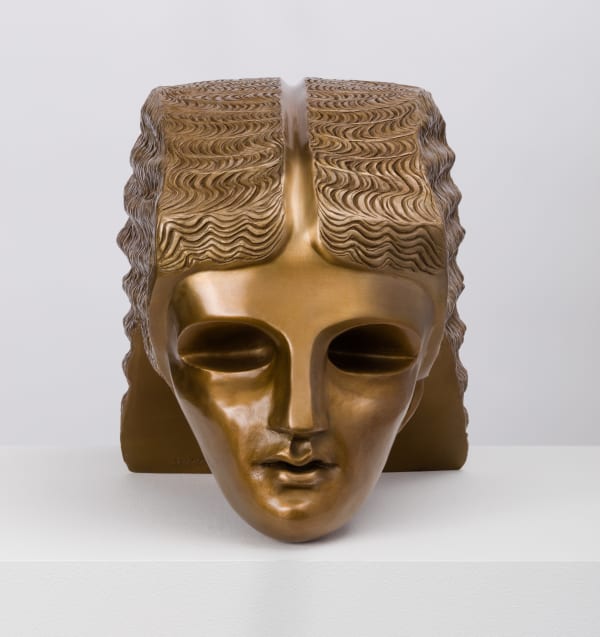Shulamit Nazarian is pleased to present High Contrast, a group exhibition curated by New York-based artist Summer Wheat. Presented in the gallery's second exhibition space, High Contrast features works by Diana Al-Hadid, Sarah Peters and Sue Williams. It will be on view concurrently with Wheat's solo exhibition, Anything Can Happen, from March 20 - May 1, 2021
High Contrast has been organized to provide viewers insight into the practices of artists that have been influential to the development and growth of Summer Wheat's aesthetic and material process. Each artist has been selected for a quality of their practice that Wheat has found particularly informative, in turn providing a reciprocal conversation that links both shows. The notion of high contrast refers to images and objects that display a full range of tones, often with bright and bold features, a commonality found either formally or conceptually in each artist's work. Also central to these artists’ practice is a critical examination of specific moments in Art History. Further to this, Wheat was selected Diana Al-Hadid to highlight her relentless exploration of material; Sarah Peters for her keen reinterpretation of figuration in Classicism, with a focus on gendered power dynamics; and Sue Williams for her use of line and lyrical forms that bravely critique social and political relations. Together, many of the themes that are central to Wheat’s own practice can be found within the work of this curated group exhibition.
Brooklyn-based, Syrian-American artist Diana Al-Hadid creates visually complex work that draws upon a variety of histories as a way to investigate the current ways in which we culturally make meaning. Built up through multiple layers of methodically-controlled dripping, Al-Hadid’s process-evident sculptures, drawings, and panel works retain the record of their physical formation, which allows for the image or subject to determine the structure of the artwork. Although entirely additive, these artworks appear to simultaneously be in a state of construction and destruction—evoking an elusive sense of time that de-contextualizes the historical circumstances and distant civilizations they reference. A blend of figurative and architectural, the artist’s sculptures utilize common materials such as cardboard, wood, plaster and metal to touch upon themes of wealth, power, and globalism. Evolving from her sculptures and described by the artist as being “somewhere between fresco and tapestry,” Al-Hadid’s three-dimensional wall panels blur the line between sculpture and painting. The artist’s ability to deftly synthesize intense material explorations with images that appear in a state of collapse culminates in artworks that are both dense, yet ethereal, and speak to the inevitable passage of time.
New York-based Sarah Peters creates sculptures that reference a diverse trove of historical iconography, from Greco-Roman tragedy masks and Assyrian antiquities, to Modernism and early American folk art. Taking the form of bronze heads, these sculptures question how age-old styles have persisted—and developed—over time within culture, religion, and art history. They consistently feature eyeless sockets and gaping mouths which function as an organizing structure for which the artist’s references can be applied. What the artist refers to as “the pleasure of contemporary misinterpretation”, the sculptures, while rooted in history, also take on resemblances to sex dolls, ventriloquist dummies, and aliens. Through the tweaking of scale and proportion, specific references become extended over others, enabling certain meanings to become revealed. This ‘mistranslation’ of ancient objects allows for the human qualities of the busts to emerge past their context in world history, resulting in a subversion of past authorities and ideas of everlasting power structures—highlighting instead the autonomy of inner human nature and its fluid definitions.
Based in New York, Sue William’s career spans 30 years of transgressive painting that explores issues of gender, the body, and hyper-masculinity found in art history. Considered one of the most significant painters of her generation, Williams has been skillfully concealing messages of violence and sexism in her paintings since the late 1980’s. The artist uses overt references to William de Kooning, Jackson Pollack, and Richard Prince, combined with the use of an anti-art aesthetic and vibrant colors to not only touch on misogyny and domesticity, but to serve as an unabashedly liberating foil to the male-dominated Abstract Expressionists. Transitioning from depicting sexually graphic content in figuration to its depictions in abstraction, her work features cartoonish compositions and playful, lyrical line, paired with explicit titling to convey a fraught-ness in meaning. In her relatively minimalist compositions, she punctures exposed canvas and fields of color with eruptions of gestural mark-making, charging the history of the painting genre with political meaning. Fields of disassembled bodies oscillate between forms of sphincters, viscera, eyeballs, and spewing orifices, evoking the psychologically complex urges that sustains not only individual human depravity, but society itself.
 Diana Al-Hadid, Untitled, 2017
Diana Al-Hadid, Untitled, 2017 Diana Al-HadidA Down and Out Pour, 2020Polymer gypsum, fiberglass, steel, plaster, pigment63.75 x 58 x 4 inches
Diana Al-HadidA Down and Out Pour, 2020Polymer gypsum, fiberglass, steel, plaster, pigment63.75 x 58 x 4 inches Sarah PetersTripod (Animal), 2016Bronze11 x 10 x 13.5 inches2 of 5
Sarah PetersTripod (Animal), 2016Bronze11 x 10 x 13.5 inches2 of 5 Sarah PetersGlossolalists, 2019Plaster11 x 25 x 12 inches1 of 1 + 1 AP
Sarah PetersGlossolalists, 2019Plaster11 x 25 x 12 inches1 of 1 + 1 AP Sue Williams, Woman and Cat, 1995
Sue Williams, Woman and Cat, 1995 Sue Williams, Fuzzy With Issues, 2018
Sue Williams, Fuzzy With Issues, 2018 Sue Williams, Bunny, Fuzzy, 1995
Sue Williams, Bunny, Fuzzy, 1995













